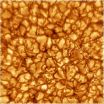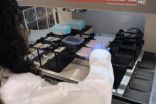How do you make lithium melt in the cold?
2011-01-11
(Press-News.org) Washington, D.C. — Sophisticated tools allow scientists to subject the basic elements of matter to conditions drastic enough to modify their behavior. By doing this, they can expand our understanding of matter. A research team including three Carnegie scientists was able to demonstrate surprising properties of the element lithium under intense pressure and low temperatures. Their results were published Jan. 9 on the Nature Physics website.
Lithium is the first metal in the periodic table and is the least dense solid element at room temperature. It is most commonly known for its use in batteries for consumer electronics, such as cell phones and laptop computers. And, with only three electrons per atom, lithium should behave like a model, simple metal.
However, this research has shown that under pressure ranging between about 395,000 atmospheres (40 GPa) and about 592,000 atmospheres (60 GPa), lithium behaves in a manner that's anything but simple. Not only does it become a liquid at room temperature, but it then refuses to freeze until the temperature reaches a chilly -115o F. At pressures above about 592,000 atmospheres (60 GPa), when lithium does eventually solidify, it is into a range of highly complex, crystalline states. The highest pressure reached in the study was about 1.3 million atmospheres (130 GPa).
The research team, including Malcolm Guthrie, Stanislav Sinogeikin and Ho-kwang (Dave) Mao, of Carnegie's Geophysical Laboratory, believe that this exotic behavior is directly due to the exceptionally low mass of the lithium atom. An elementary result of quantum physics is that atoms continue to move, even when cooled to the lowest possible temperature. As the mass of an atom decreases, the importance of this residual, so called 'zero-point,' energy increases. The researchers speculate that, in the case of lithium, the zero-point energy increases with pressure to the point that melting occurs. This work raises the possibility of uncovering a material which never freezes. The prospect of a metallic liquid at even the lowest temperatures raises the intriguing possibility of an entirely novel material, a superconducting liquid, as proposed previously by theorists for hydrogen at very high pressure.
INFORMATION:
This work is supported by a research grant from the UK Engineering and Physical Sciences Research Council and facilities made available by the European Synchrotron Radiation Facility. It is also based on work supported as part of the EFree initiative, funded by the US Department of Energy, Office of Science. HPCAT, where some of the research was conducted, is supported by DOE-BES, DOE-NNSA, and NSF. APS, where some data were collected is supported by DOE-BES, One of the researchers received support from the Royal Society.
The Carnegie Institution for Science (carnegiescience.edu) is a private, nonprofit organization headquartered in Washington, D.C., with six research departments throughout the U.S. Since its founding in 1902, the Carnegie Institution has been a pioneering force in basic scientific research. Carnegie scientists are leaders in plant biology, developmental biology, astronomy, materials science, global ecology, and Earth and planetary science.
ELSE PRESS RELEASES FROM THIS DATE:
2011-01-11
DURHAM, N.H. – An international team of researchers, including several from the University of New Hampshire, have completed the first DNA sequence of any strawberry plant, giving breeders much-needed tools to create tastier, healthier strawberries. Tom Davis, professor of biological sciences at UNH, and postdoctoral researcher Bo Liu were significant contributors to the genome sequence of the woodland strawberry, which was published last month in the journal Nature Genetics.
"We now have a resource for everybody who's interested in strawberry genetics. We can answer questions ...
2011-01-11
NJIT Distinguished Professor Philip R. Goode and the research team at Big Bear Solar Observatory (BBSO) have reported new insights into the small-scale dynamics of the Sun's photosphere. The observations were made during a period of historic inactivity on the Sun and reported in The Astrophysical Journal . http://iopscience.iop.org/2041-8205/714/1/L31 The high-resolution capabilities of BBSO's new 1.6-meter aperture solar telescope have made such work possible.
"The smallest scale photospheric magnetic field seems to come in isolated points in the dark intergranular ...
2011-01-11
PROVIDENCE, R.I. [Brown University] — In the longest-term study so far to track people with body dysmorphic disorder, a severe mental illness in which sufferers obsess over nonexistent or slight defects in their physical appearance, researchers at Brown University and Rhode Island Hospital found high rates of recovery, although recovery can take more than five years.
The results, based on following 15 sufferers of the disease over an eight-year span, appear in the current issue of the Journal of Nervous and Mental Disease.
"Compared to what we expected based on a prior ...
2011-01-11
In recent years, developers have been investigating light-harvesting thin film solar panels made from nanotechnology –– and promoting efficiency metrics to make the technology marketable. Now a Tel Aviv University researcher is providing new evidence to challenge recent "charge" measurements for increasing solar panel efficiency.
Offering a less expensive, smaller solution than traditional panels, Prof. Eran Rabani of Tel Aviv University's School of Chemistry at the Raymond and Beverly Sackler Faculty of Exact Sciences puts a lid on some current hype that promises to ...
2011-01-11
A new study conducted by Josh LaBaer's research team in the Biodesign Institute at Arizona State University has pinpointed more than 30 breast cancer gene targets ---including several novel genes---that are involved in drug resistance to a leading chemotherapy treatment.
The results of the study may one day aid in the treatment of the one in ten U.S. women who will develop breast cancer, by empowering physicians with a more personalized approach to therapy as well as a new tool for the early screening of those that may ultimately become resistant to chemotherapy.
Drugs ...
2011-01-11
CHAMPAIGN, Ill. — Using detailed land analysis, Illinois researchers have found that biofuel crops cultivated on available land could produce up to half of the world's current fuel consumption – without affecting food crops or pastureland.
Published in the journal Environmental Science and Technology, the study led by civil and environmental engineering professor Ximing Cai identified land around the globe available to produce grass crops for biofuels, with minimal impact on agriculture or the environment.
Many studies on biofuel crop viability focus on biomass yield, ...
2011-01-11
University of Illinois research reports that several herbicides used on corn also have good selectivity to Miscanthus x giganteus (Giant Miscanthus), a potential bioenergy feedstock.
"No herbicides are currently labeled for use in Giant Miscanthus grown for biomass," said Eric Anderson, an instructor of bioenergy for the Center of Advanced BioEnergy Research at the University of Illinois. "Our research shows that several herbicides used on corn are also safe on this rhizomatous grass."
M. x giganteus is sterile and predominantly grown by vegetative propagation, or planting ...
2011-01-11
WEST LAFAYETTE, Ind. - Large hypoxic zones low in oxygen long have been thought to have negative influences on aquatic life, but a Purdue University study shows that while these so-called dead zones have an adverse affect, not all species are impacted equally.
Tomas Höök, an assistant professor of forestry and natural resources, and former Purdue postdoctoral researcher Kristen Arend used output from a model to estimate how much dissolved oxygen was present in Lake Erie's hypoxic zone each day from 1987 to 2005. That information was compared with biological ...
2011-01-11
AUSTIN, Texas — Growing up poor can suppress a child's genetic potential to excel cognitively even before the age of 2, according to research from psychologists at The University of Texas at Austin.
Half of the gains that wealthier children show on tests of mental ability between 10 months and 2 years of age can be attributed to their genes, the study finds. But children from poorer families, who already lag behind their peers by that age, show almost no improvements that are driven by their genetic makeup.
The study of 750 sets of twins by Assistant Professor Elliot ...
2011-01-11
University of California, Berkeley, astronomers may have found the missing link between gas-filled, star-forming galaxies and older, gas-depleted galaxies typically characterized as "red and dead."
In a poster to be presented this week at the American Astronomical Society meeting in Seattle, UC Berkeley astronomers report that a long-known "early-type" galaxy, NGC 1266, is expelling molecular gas, mostly hydrogen, from its core.
Astronomers have long recognized the distinction between early-type red and dead galaxies, thought to be largely devoid of gas and dust and ...
LAST 30 PRESS RELEASES:
[Press-News.org] How do you make lithium melt in the cold?





